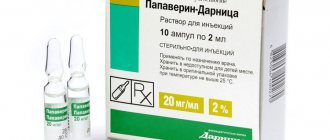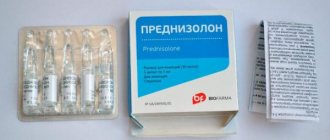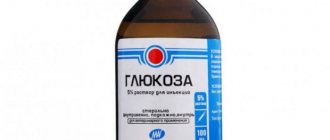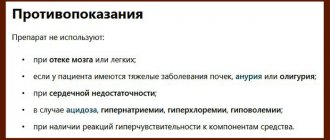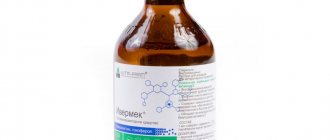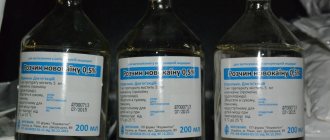Save the article:
The drug Phosprenyl is an effective antiviral agent that has been used in veterinary medicine for many years to boost the immunity of animals and fight viruses. The medication has a specific list of indications, which allows it to be used to treat cats with serious diseases. The method of application is determined by the chemical composition and form of release of the drug.
Indications for use
global $ads_google; //data-ad-slot=”2475549904″ $ads_google = empty($ads_google) ? false : true; ?> if ($ads_google == false) {?>
$ads_google = true; ?> } ?>
Fosprenil for cats and other domestic animals is used for both preventive and therapeutic purposes. It is included in the scheme of complex stepwise therapy for many diseases. Veterinarians prescribe Fosprenil for:
- prevention of mild and severe viral diseases;
- increasing the body's resistance to unfavorable factors;
- strengthening the immune response when the vaccine is administered;
- prevention of complications after vaccination.
The biological effect of the drug justifies its use for herpes, hepatitis, rhinotracheitis, peritonitis, coronavirus, panleukopenia, digestive disorders of unknown origin, food poisoning and other problems.
When revaccinating cats, Fosprenil is not used.
Release form and composition
The production of Fosprenil for cats and other pets is carried out by Moscow. The drug is marketed as an injection solution. The transparent, slightly opalescent liquid may have a light yellow tint and is completely odorless. The sterile liquid is poured into 10 or 50 ml glass bottles. The containers are sealed with a rubber lid and secured with an aluminum clamp.
Each milliliter of the drug contains 4 mg of dry disodium salt of polyprenols phosphate. This active compound is of plant origin. It is obtained from pine and fir needles. The formula of the solution includes water, glycerin, ethanol, and Tween-80 as auxiliary components.
Dosage
Single and daily doses of Fosprenil depend on the age category and body weight of the animal. For adult cats, the dosage for one dose is calculated at the rate of 0.2 ml per kilogram of weight. For kittens it is 0.3 ml/kg. In this case, the total daily amount for adult cats is 0.6-0.8 ml/kg. Kittens are administered no more than 0.9-1.2 ml per day. If the calculated daily volume of the medicine turns out to be large, then the solution is injected into two or three places on the body or the drug is divided into several injections during the day.
When administered intravenously, the dose of liquid Phosprenyl is reduced: for cats it is 0.1 ml/kg (one-time) and 0.3-0.4 ml/kg (per day), and for babies – 0.15 ml/kg and 0. 45-0.6 ml/kg, respectively. If the drug is prescribed to stimulate the immune system during vaccination, the single dose is 0.05 ml/kg.
In especially severe cases, when the cat’s body cannot cope with the disease and there is a threat to life, the usual dosage of Fosprenil is doubled
global $ads_google;
//data-ad-slot=”2475549904″ $ads_google = empty($ads_google) ? false : true; ?> if ($ads_google == false) {?> $ads_google = true; ?> } ?> Fosprenil injections or oral administration are continued until signs of the disease are completely eliminated and therapy is completed after 2-3 days to consolidate the effect. The standard course of treatment with this antiviral drug is at least 5-7 days. The exact duration of treatment is prescribed by the veterinarian, based on the severity of the disease and the condition of the cat.
| AGREED Deputy Head of Rosselkhoznadzor ________________________ ________________________ ________________________ |
INSTRUCTIONS
on the use of Fosprenil to stimulate nonspecific resistance
and treatment of viral infections in animals and birds
(developer organization: Micro-plus CJSC, 123098 Moscow, Gamaleyi St., 18)
1. General information
1. Trade name of the drug: Phosprenyl.
International nonproprietary name: disodium salt of polyprenols phosphate.
2. Dosage form: solution for injection.
Fosprenil contains 4 mg of disodium salt of polyprenols phosphate in 1 ml as an active substance, and glycerin, ethanol, Tween-80 and water for injection as excipients.
3. In appearance, the drug is a transparent or slightly opalescent solution, colorless or with a yellowish tint.
The shelf life of the medicinal product, subject to storage conditions, is 2 years from the date of production. After opening the initial packaging, the drug cannot be stored.
Do not use Fosprenil after the expiration date.
4. Fosprenil is produced packaged in 10 ml and 50 ml glass bottles of appropriate capacity, sealed with rubber stoppers reinforced with aluminum caps.
Vials with the drug are placed in cardboard packs. Each unit of packaging is supplied with instructions for use.
5. Fosprenil should be stored in the manufacturer’s sealed packaging, separate from food and feed, in a dry place, protected from direct sunlight, at a temperature of 4°C to 25°C.
6. The drug should be stored out of the reach of children.
7. Unused medicinal product is disposed of in accordance with legal requirements.
8. Dispensing conditions: without a veterinarian's prescription.
II Pharmacological properties
9. Fosprenil is an antiviral drug with immunomodulatory properties.
10. Disodium salt of polyprenols phosphate, which is part of the drug, activates natural resistance systems (bactericidal activity of blood serum and phagocytosis), enhances the humoral immune response to vaccines, thereby increasing the body's resistance to infections and reducing morbidity. Disodium phosphate salt of polyprenols activates metabolic processes in cells and, accordingly, increases weight gain while reducing feed costs. Disodium phosphate salt of polyprenols has antiviral activity against paramyxoviruses, orthomyxoviruses, togaviruses, herpesviruses, coronaviruses and some other viruses. After parenteral administration, disodium salt of polyprenols phosphate enters the animal’s bloodstream, accumulates mainly in the tissues of the liver, spleen and reproductive organs, reaching maximum concentrations after 0.5-3 hours and remains at a therapeutic level for 10-16 hours. It is excreted from the body mainly in feces and urine.
In terms of the degree of impact on the body, Fosprenil is classified as a low-hazard substance (hazard class 4 according to GOST 12.1.007-76); in recommended doses it does not have a locally irritating, allergenic, embryotoxic, teratogenic or carcinogenic effect.
III. Application procedure
11. Fosprenil is used in agricultural animals, domestic animals, fur-bearing animals and poultry to stimulate nonspecific resistance, for the prevention and treatment of viral infections, enhancing the immune response to vaccine administration, reducing morbidity and increasing weight gain in animals and poultry.
12. A contraindication to the use of the drug is the increased individual sensitivity of animals and birds to the components of Fosprenil.
13. The drug can be used in various ways: intramuscularly, subcutaneously, intravenously (in horses and productive animals) or orally.
Treatment with Fosprenil should be started as early as possible after the onset of clinical signs of the disease. Therapy is most effective in the prodromal period. For viral infections, it is necessary to combine Fosprenil with symptomatic and pathogenetic therapy, especially in severe and complicated forms of infections. In severe cases of the disease, it is recommended to double the therapeutic dose of Fosprenil. Treatment is stopped 2-3 days after the main symptoms of the disease disappear. If necessary, repeated courses of treatment may be prescribed.
When treating viral infections of small domestic animals, Fosprenil is prescribed for 5-7 days in the doses (ml/kg) indicated in Table 1.
Table 1
| Animal species | Puppies | Dogs | Kittens | Cats |
| Single dose | 0,3 | 0,2 | 0,3 | 0,2 |
| Daily dose | 0,9-1,2 | 0,6-0,8 | 0,9-1,2 | 0,6-0,8 |
With a large daily dose, Fosprenil should be administered either at two or three points, or in three to four injections during the day.
For canine distemper in dogs, in order to avoid relapses, the drug should be administered for at least 14 days, even if the clinical signs of the disease disappear. The duration of the course, if necessary, can be increased to 1 month.
For the purpose of nonspecific prevention of diseases and reduction of mortality, Fosprenil is administered at a dose of 0.05 ml/kg body weight according to the schedule indicated in Table 2.
table 2
| Kind of animal | Infections | Method of administration | Number of injections | |||||
| Days after starting prophylaxis: | ||||||||
| 1 | 2 | 3 | 5 | 10 | 15 | |||
| Pigs | Intestinal | in/muscularly, orally | 1 | 1 | 1 | |||
| Chickens | Respiratory | aerosol* | 1 | 1 | 1 | 1 | 1 | 1 |
| Intestinal | orally | 1 | 1 | 1 | ||||
| Horses | Respiratory | IV | 1 | 1 | 1 | 1 | 1 | 1 |
| Intestinal | IV | 1 | 1 | 1 | ||||
| Minks | Secondary infections in Aleutian disease | orally | Once every 5-7 days during the entire production cycle | |||||
* - to prepare a working solution, 20 ml of Fosprenil is diluted in 1 liter of water with 10% glycerin and sprayed using aerosol generators such as SAG or APA at the rate of 0.4 ml of working solution per 1 m3 of poultry room with an exposure of 15 minutes.
To reduce morbidity, mortality, increase weight gain, reduce feed costs for young animals (pigs, horses, cattle) and poultry (chickens) in the first month of life, Fosprenil is administered in a prophylactic dose of 0.05 ml/kg intramuscularly, orally or in birds with water on the 2nd, 5th, 10th, 14th and 20th days of life. Fosprenil is given to fur-bearing animals with food once every 7 days during the 1st month after weaning, then once every 14 days before slaughter.
In order to increase the immune response to vaccines and prevent post-vaccination complications, Fosprenil at a dose of 0.05 ml/kg is administered simultaneously with the vaccine in different syringes intramuscularly, orally or in birds with water. The drug is not used for revaccination.
14. There have been no cases of overdose, side effects or complications with the use of Fosprenil.
15. No specific effects were identified during the first use of the drug and upon its discontinuation.
16. Fosprenil can be used in pregnant animals, in animals during lactation and in the offspring of animals and birds.
17. Omissions should be avoided when administering the next dose of Fosprenil, as this may lead to a decrease in the therapeutic effectiveness of the drug. If you miss one dose, give it as soon as possible. Further, the interval until the next administration of the drug does not change.
18. When using Fosprenil in accordance with these instructions, side effects and complications, as a rule, are not observed.
If allergic reactions occur, stop using the drug and prescribe antihistamines or other symptomatic treatment.
19. The drug is not recommended for use with steroid drugs due to a decrease in the therapeutic effect of Fosprenil. It is not recommended to dilute Fosprenil with saline solutions.
20. Products from animals and birds that have been treated with Fosprenil are used for food purposes without restrictions.
IV. Personal prevention measures
21. When using the drug, it is necessary to follow the rules of personal hygiene and safety precautions provided for when working with medicinal products for veterinary use.
22. All work with Fosprenil should be carried out using special clothing and personal protective equipment (rubber gloves, goggles, respirator or protective mask). While working with the drug, do not drink, smoke or eat. At the end of the work, you should thoroughly wash your face and hands with soap and rinse your mouth with water.
Empty medicinal product containers must not be used for household purposes; it must be disposed of with household waste.
23. People with hypersensitivity to the components of the drug should avoid direct contact with Fosprenil. If the drug accidentally gets on the skin or mucous membranes, it should be washed off immediately with running water and soap. If allergic reactions occur and/or if the drug accidentally enters the human body, you should immediately contact a medical facility (bring with you the instructions for use of the drug or the label).
How it works
An antiviral drug containing polyprenolic phosphates has a whole range of useful properties. They determine the therapeutic effect of the drug. The immunomodulatory effect of Fosprenil in the body consists of the following processes:
- Strengthening the phagocytic function of leukocytes.
- Increased bactericidal activity of whey proteins.
- Stimulation of the synthesis of own antibodies.
- Activation of metabolic processes inside cells.
- Decreased activity of viral particles.
- Restoration of cellular structures.
- Increased antioxidant protection.
As a result of complex biochemical changes, the cat’s body reacts more adequately to the introduction of viruses into cells and more actively fights infection. Recovery is faster and more stable. With Fosprenil, the animal more actively restores its weight, even if the amount of feed is not increased.
Fosprenil is able to directly affect certain types of viruses. In particular, paramyxovirus, orthomyxovirus, togavirus, herpesvirus, coronavirus and some other non-cellular forms are susceptible to it.
After the injection, the drug enters the blood vessels and spreads throughout the body. The highest concentration of active drug compounds in the blood is achieved after half an hour. The therapeutic maximum is maintained for up to 10-16 hours. During this time, the drug manages to have a therapeutic effect. Accumulation of active substances is observed in the liver, spleen, and genitals. Excretion of half-life products occurs through the kidneys with urine and through the intestines with feces.
Pharmacological properties
The action of "Fosprenil" is aimed at increasing the intensity of the work of cells of the immune system (phagocytes) and increasing the number of antibodies in the body. The drug, by stimulating the immune system, increases the body's resistance and has an anti-inflammatory effect.
You can also inject cats with such immunostimulating drugs as: “Gamavit”, “Fospasim”, “Ketofen” and “Vakderm”.
Instructions for use of Fosprenil
The sterile solution is intended for injection or oral use. The injection is given in any of three ways: intramuscularly, intravenously, subcutaneously. The earlier treatment is started, the greater the chances of getting a positive result and achieving recovery for the cat. Veterinarians recommend starting to administer Fosprenil in the prodromal period, that is, in the interval between the incubation period and the immediate manifestation of symptoms of the disease.
During treatment with this drug, it is advisable to follow the injection schedule. If one is missed, the next dose should be administered as soon as possible. In this case, the amount of the drug does not exceed. The solution is also used to wash the eyes and nasal cavity of a pet during viral infections.
In order not to reduce the therapeutic effect, Fosprenil is not combined with steroid medications
How to inject medicine into a cat
An intramuscular injection of Fosprenil is given into large skeletal muscles. The first place is located in the upper thigh. The needle is inserted from the tail. The second place is located in the upper third of the shoulder. The needle is inserted from behind the abdomen. The withers or the area between the shoulder blades is suitable for subcutaneous injection. The skin is lifted with your fingers and a needle is inserted under the fold.
global $ads_google; //data-ad-slot=”2475549904″ $ads_google = empty($ads_google) ? false : true; ?> if ($ads_google == false) {?>
$ads_google = true; ?> } ?>
Intravenous administration of the drug requires skill. If it is absent, you should not experiment at home; it is recommended to go to the clinic. The intravenous injection technique involves several sequential manipulations:
- The paw is tied with a tourniquet.
- A needle without a syringe is inserted into the distended vein.
- Connect a syringe with medicine to the needle.
- Allow blood to enter the cavity of the syringe.
- Remove the applied tourniquet.
- The drug is slowly injected into a vein.
Fosprenil injection is not recommended to be diluted with saline solutions
Side effects and overdose
Fosprenil for cats is a low-toxic medicine that does not cause serious disturbances in the body. According to GOST 12.1.007-76, polyprenol phosphates belong to hazard class 4. No mutagenic, carcinogenic, teratogenic, or embryotoxic effects have been detected for this medication. The injections do not cause local irritation of the skin, and the drug itself is not an allergen.
In clinical trials of Fosprenil, no negative consequences were observed after exceeding the dosage of the drug. During a course of treatment, in some cases cats may experience an allergic reaction. When the first suspicious changes in the cat’s well-being appear, it is necessary to stop the injections, give the pet an antihistamine and contact a veterinary clinic. These symptoms include increased body temperature, increased heart rate, drowsiness, and apathy.
When is Fosprenil prescribed to cats?
O is a drug that is advisable to use as an emergency aid, for example, when a cat has been in contact with another animal suffering from a viral disease. Fosprenil is used in situations where the animal was taken from the street or from unfavorable conditions. The main advantage of Fosprenil is its almost instantaneous action aimed at stopping the infection.
Discharge from the eyes is a symptom of a viral disease in a cat.
In other cases, the drug is prescribed if a cat is diagnosed with ailments such as infectious inflammation of the abdominal cavity, food poisoning, intoxication, and diseases of the respiratory system.
Table 1. What diseases is Fosprenil effective against?
| Disease | Symptoms |
| Herpesvirus | Increased body temperature to 40 degrees, severe flow from the nose and eyes. A whitish coating on the surface of the nose and mucous membranes. |
| Orthomyxovirus | Photophobia, elevated body temperature, apathy, swelling of the mucous membranes of the eyes and nose, dry cough. |
| Calcevirosis | Refusal to eat, lethargy, runny nose, ulcerative lesions in the mouth, rapid breathing, shortness of breath. Lameness and manifestations of arthritis are possible. |
| Rhinotracheitis (infectious) | Loss of appetite, depressed behavior, sneezing, nasal discharge, increased body temperature. |
| Coronavirus | Diarrhea, vomiting, runny nose and eyes, weight loss, anemia and pale mucous membranes. Nervous system lesions. |
| Paramyxovirus | Pronounced “cold” symptoms, lethargic behavior, the cat hides, refuses affection and communication. Loss of appetite, deterioration in general appearance. |
Calcevirosis in cats
Video - How to understand that a cat has a viral infection?
Analogs
The line of antiviral and immunomodulatory drugs for cats with an effect similar to Fosprenil includes several medications. Their active ingredients may differ. But the main action and indications for use of the analogues are the same. Such means include:
Gamavit
. Adaptogen is obtained from animal placenta. The biologically active complex contains vitamins, amino acids, and minerals. Available as a sterile solution for injection or oral use.
Maxidin
. The formula is based on germanium-organic compounds. The immunomodulator is available in the form of an injection solution and eye drops.
Forvet
. The active complex consists of mono- and polysaccharides obtained from plant materials. There are two dosage forms: injection solution and eye drops.
Fosprenil analogues for animals
In general, the drug is not an expensive wonder - its price is quite affordable. You can buy this medicine at any veterinary pharmacy. But in some cases, animals may experience an allergic reaction. Then you can replace Fosprenil with another drug with a similar effect. It could be:
- Maxidin.
- Gamavit.
- Forvet.
All three drugs are also of natural origin and are indicated for the treatment of viral diseases in animals.

